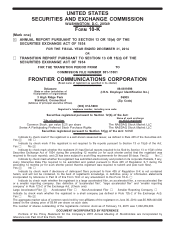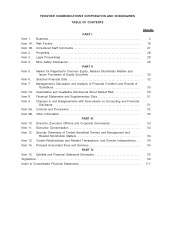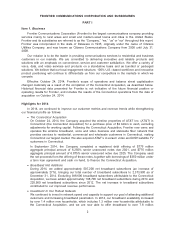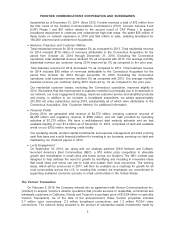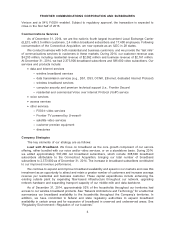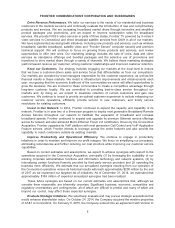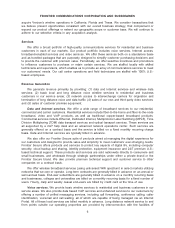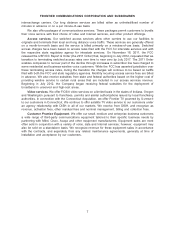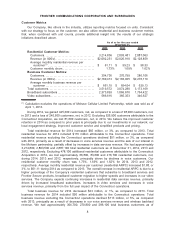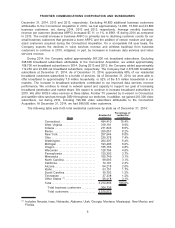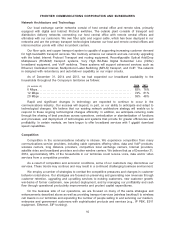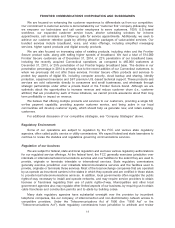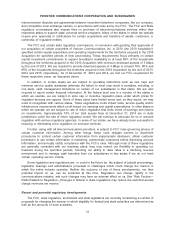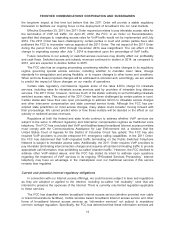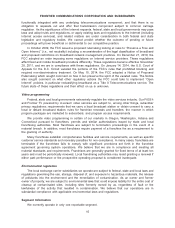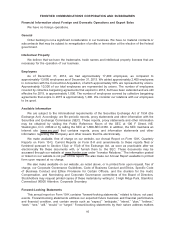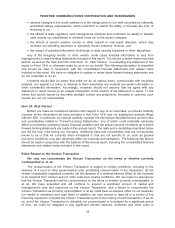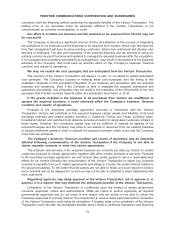Frontier Communications 2014 Annual Report Download - page 11
Download and view the complete annual report
Please find page 11 of the 2014 Frontier Communications annual report below. You can navigate through the pages in the report by either clicking on the pages listed below, or by using the keyword search tool below to find specific information within the annual report.
Network Architecture and Technology
Our local exchange carrier networks consist of host central office and remote sites, primarily
equipped with digital and Internet Protocol switches. The outside plant consists of transport and
distribution delivery networks connecting our host central office with remote central offices and
ultimately with our customers. We own fiber optic and copper cable, which has been deployed in our
networks and are the primary transport technologies between our host and remote central offices and
interconnection points with other incumbent carriers.
Our fiber optic and copper transport system is capable of supporting increasing customer demand
for high bandwidth transport services. We routinely enhance our network and are currently upgrading
with the latest Internet Protocol Transport and routing equipment, Reconfigurable Optical Add/Drop
Multiplexers (ROADM) transport systems, Very High Bit-Rate Digital Subscriber Line (VDSL)
broadband equipment, and VoIP switches. These systems will support advanced services such as
Ethernet, Dedicated Internet, Multiprotocol Label Switching (MPLS) transport, and VoIP. The network
is designed with redundancy and auto-failover capability on our major circuits.
As of December 31, 2014 and 2013, we had expanded our broadband availability to the
households throughout the Company’s territories as follows:
(In excess of) 2014 2013
6 Mbps. . . . . . . . . . . . . . . . . . . . . . . . . . . . . . . . . . . . . . . . . . . . . . . . . . . . . . . . . . . . . . . . . . . . . 83% 76%
12 Mbps . . . . . . . . . . . . . . . . . . . . . . . . . . . . . . . . . . . . . . . . . . . . . . . . . . . . . . . . . . . . . . . . . . . 74% 61%
20 Mbps . . . . . . . . . . . . . . . . . . . . . . . . . . . . . . . . . . . . . . . . . . . . . . . . . . . . . . . . . . . . . . . . . . . 55% 48%
Rapid and significant changes in technology are expected to continue to occur in the
communications industry. Our success will depend, in part, on our ability to anticipate and adapt to
technological changes. We believe that our existing network architecture strategy will enable us to
respond to these ongoing technological changes efficiently. In addition, we anticipate reducing costs
through the sharing of best practices across operations, centralization or standardization of functions
and processes, and deployment of technologies and systems that provide for greater efficiencies and
profitability. In certain markets, we have begun to offer broadband services with 1 gigabit download
speed capabilities.
Competition
Competition in the communications industry is intense. We experience competition from many
communications service providers, including cable operators offering video, data and VoIP products,
wireless carriers, long distance providers, competitive local exchange carriers, Internet providers,
satellite video and broadband providers and other wireline carriers. We believe that as of December 31,
2014, approximately 96% of the households in our territories could receive voice, data and/or video
services from a competitive provider.
As a result of competition and economic conditions, some of our customers may discontinue our
services. These trends may continue and may result in a continued challenging business environment.
We employ a number of strategies to combat the competitive pressures and changes in customer
behavior noted above. Our strategies are focused on preserving and generating new revenues through
customer retention, upgrading and up-selling services to existing customers, new customer growth,
win-backs of former customers, new product deployment, and by managing our profitability and cash
flow through operational productivity improvements and prudent capital expenditures.
On the business side of our operations, we are focused on many of the same strategies and
enhancements described above as well as providing transport services (wireless backhaul) to wireless
cell towers in our territories and expanding the number of people selling to and servicing our medium,
enterprise and government customers with sophisticated products and services (e.g., IP PBX, E911
equipment, Ethernet, SIP trunking).
10
FRONTIER COMMUNICATIONS CORPORATION AND SUBSIDIARIES

